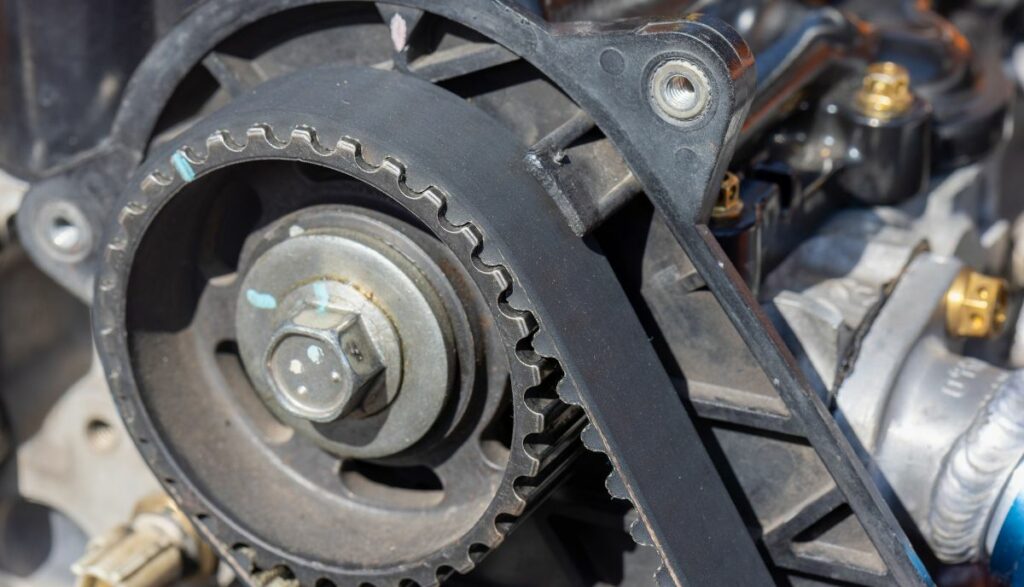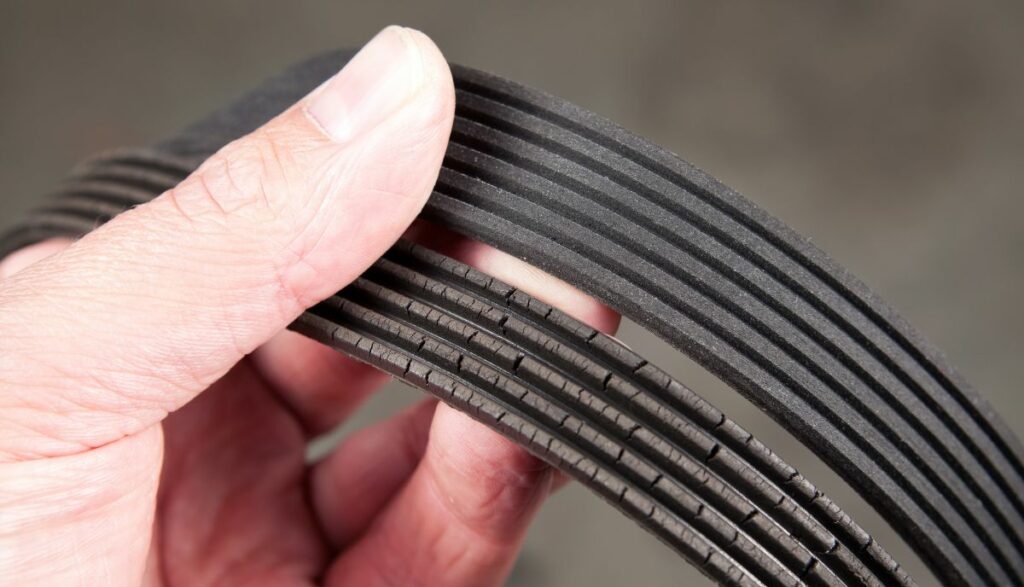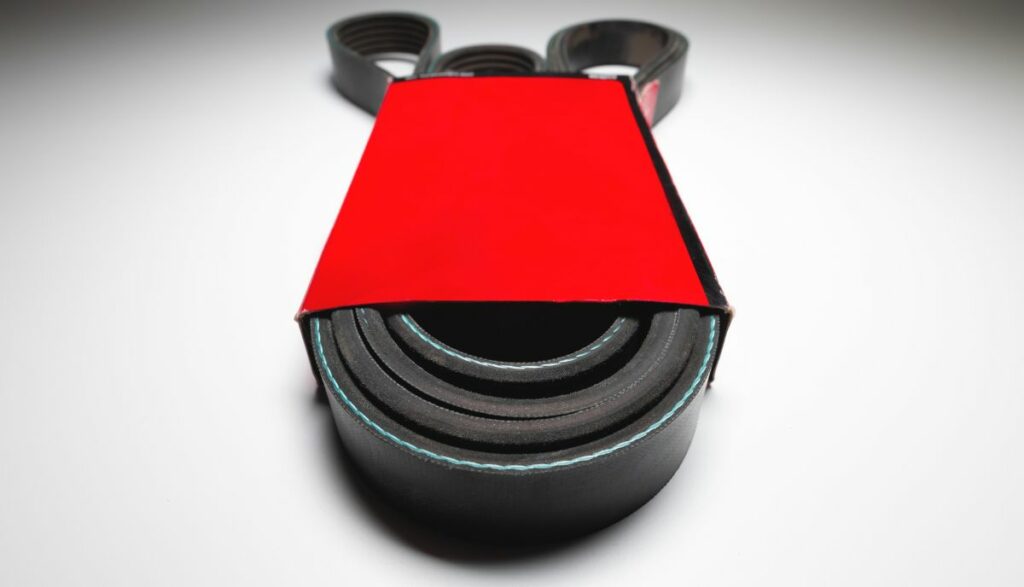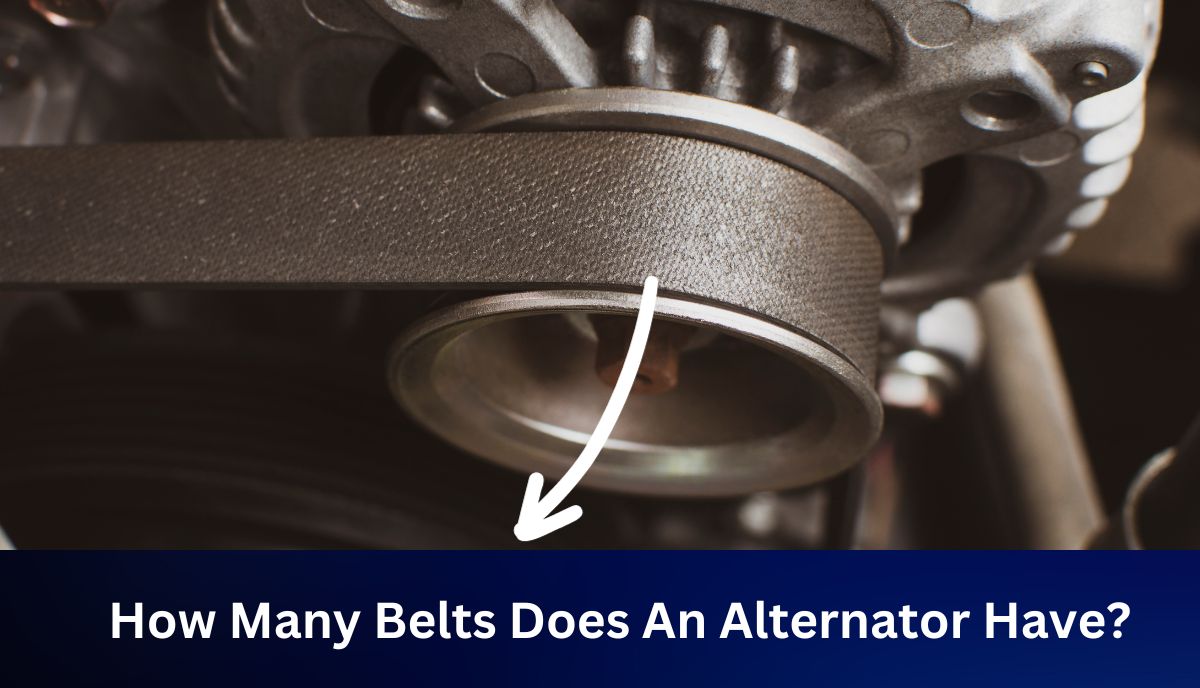An alternator has one belt. The name will vary depending on your location. Some people call it the ‘Drive belt.’ Others use ‘V Belt,’ ‘Fan Belt,’ or ‘Serpentine Belt.’ On the surface, the terminology doesn’t matter. The alternator needs one belt.
That said, you have other components in that area, such as the water pump, radiator fan, and air conditioner. Those components use belts. When a mechanic asks whether your vehicle has one belt or multiple belts, they want to know whether each component has a separate belt or if the same belt runs everything. Your options typically include the following:
1). Timing Belt
The timing belt is not concerned with the alternator. However, it helps to understand what it looks like and the function it performs. This prevents laypeople from confusing the timing belt with the alternator and v belts.

The component immediately stands out because it has notches you won’t find in drive belts. The belt replaced the timing chains you found in older vehicles.
It matches the timing of the pistons while opening and closing the engine valves. Cars with old and worn-out timing belts generate a slapping noise.
2). Serpentine Belt

The serpentine belt drives multiple components. You may find it under the names like ‘Accessory belt’ or ‘Drive Belt.’ Either way, the belt is long, and it has deep grooves. The length matters because the belt winds through pulleys connected to the water pump, alternator, AC, and power steering pump.
The crankshaft uses the serpentine belt to run all four components when it spins. The grooves are vital because they increase contact between the belt and the pulleys. This is why mechanics replace belts with worn-out grooves. You can drive a car for 100,000 miles before replacing a serpentine belt.
3). V Belt

V-belts are not new. A paper from the Poznan University of Technology in Poland traces their origins to 1917 when John Gates added them to a vehicle’s powertrain.
They became commonplace in various industries because of their properties and inexpensive production.
They got their name from the shape. A V-belt’s cutaway image looks like a V or a wedge. In some circles, mechanics use the term ‘V-belt’ for the belt running the alternator. Their classifications include two additional belts, namely:
- Power Steering Belt
As the name suggests, the power steering belt snakes around the pulley that operates the power steering pump. The power steering pump is responsible for the mechanism that allows the driver to turn the steering wheel with greater ease. A working pump will pressurize the hydraulic fluid.
- AC Belt
The air conditioning belt spins the AC compressor clutch. It works with a tensioner.
What Determines The Quantity Of Belts In Alternator Systems?
The vehicle’s design will determine the number of belts. Each option has advantages and disadvantages. For instance:
1). Serpentine Belt
- Serpentine belts are easier to install and maintain. This is because they consist of one belt that snakes through multiple pulleys.
- Serpentine belts are thicker than v-belts.
- Serpentine belts are flatter. This gives them more traction, which, in turn, allows the belts to generate more power.
- Serpentine belts have more tension than their V-belt counterparts. A belt that snakes through multiple pulleys is unlikely to lose tension.
- The thickness of the belt reduces the chances of slippage.
- The serpentine belt is lighter than a traditional V-belt.
- Serpentine belts do not flip.
- Cars with serpentine belts require one belt tensioner. Therefore, they consume less space.
- If the serpentine belt fails, multiple components will suffer because a single belt runs them all. You may lose functionality in the alternator, AC, cooling fan, and pumps. There are no redundancies.
- Serpentine belts are easier to modify because you only have one belt.
2). V-belts
- V-belts are somewhat inconvenient because you have multiple belts running numerous components. This makes them more challenging to install and maintain.
- If you misalign them slightly, v-belts have a ‘deep V’ that guides them back into their proper place.
- V-belts are smaller. As a result, they fit on pulleys that are equally small. This makes their configuration compact.
- If one belt fails or slips off, the others will keep running. The first belt can cause the other belts to also slip. But that won’t happen immediately. You have some room to breathe.
- The V-belt cannot match a serpentine belt’s traction because it can only guarantee a secure grip on a pulley on the narrow sides of the V. Expect some friction loss.
- Despite their benefits, you can’t trust V-belts to handle the higher RPMs serpentine belts routinely tolerate.
- V-belts can flip because of improper tension, the wrong belt type, incorrect size, and misaligned pulleys, forcing the driver to buy a replacement.
- It may cost you more to replace V-belts because you need multiple belts. However, some serpentine belts are incredibly expensive. A single serpentine belt’s price tag can exceed the cost of three or more V-belts.
On the whole, serpentine belts are superior. They are thicker and offer better traction and tension.
However, you can get by with either option. This guide from Doctor Ali Kamil (Lecutre No. 6) mentions the variables that affect the amount of power a belt transmits. They include the velocity, tension, and the arc of contact. Notice how it doesn’t mention the belt type.
You can make some modifications to accommodate either style, depending on your preferences. Some experts think three drive belts are better because they distribute the load. Most mechanics prefer to stick to the manufacturer’s recommendation. They will give your vehicle the belt type it was designed to accommodate.
Are Multi-Belt Alternator Setups Common In Certain Vehicles?
Yes, different belt types tend to appear in different vehicles. Multiple V-belts are common in older models. They were the norm for decades. But then serpentine belts entered the picture and replaced them.
Great Bend Tribune blames Jim Vance for the innovation. He noticed that the automotive industry was continuously adding new accessories to cars and invented a belt to drive them all in 1974.
Both options perform a similar function. They deliver power to the alternator, power steering pump, AC, etc. But serpentine belts are gradually forcing V-belts out of the market because they are thicker, flatter, lighter, and easier to install and maintain.
How Does The Number Of Belts Affect Alternator Performance?
The serpentine belt is better for the alternator’s performance, but not because it is one belt. The serpentine belt has superior tension and traction because of its thick, wide, flat design. If a mechanic modifies your vehicle to use multiple V-belts instead of one serpentine belt, you won’t notice the difference while driving the car.

